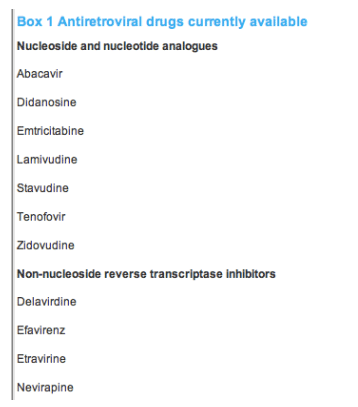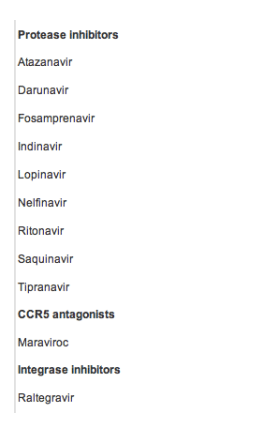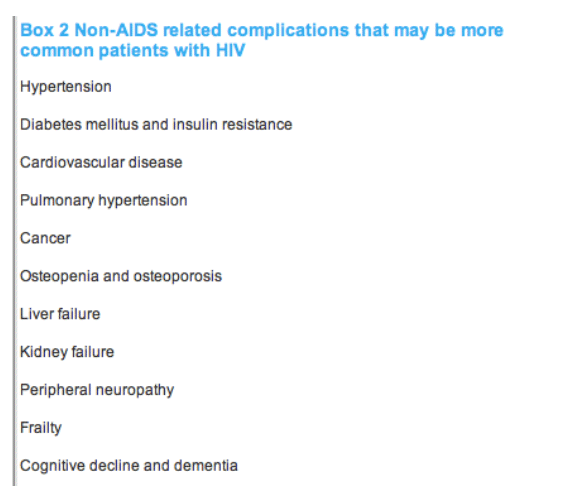| |
HIV infection, antiretroviral treatment, ageing, and non-AIDS related morbidity: review by Steve Deeks and Andrew Phillips
|
| |
| |
Clinical Review
Published 26 January 2009, doi:10.1136/bmj.a3172
Cite this as: BMJ 2009;338:a3172
Steven G Deeks, professor of medicine1, Andrew N Phillips, professor of epidemiology2
1 Positive Health Program, San Francisco General Hospital, University of California, San Francisco, CA 94131, USA , 2 HIV Epidemiology and Biostatistics Group, Department of Primary Care and Population Sciences, and Royal Free Centre for HIV Medicine, Royal Free and University College Medical School, University College London, London NW3 2PF
"Although effective antiretroviral treatment prevents AIDS and non-AIDS related morbidity and mortality, treatment does not fully restore health.".... "In the French population, mortality in HIV infected patients approached that in uninfected patients only if treatment could durably increase peripheral CD4+ T cell counts into the normal range."..... "peripheral CD4+ T cell count during long term antiretroviral treatment is a consistent predictor of non-AIDS related events" (from Jules: viral load also in some studies has been a predictor of some non-AIDS related events)
"In treated patients who achieve durable suppression of the HIV virus, natural ageing, drug specific toxicity, lifestyle factors, persistent inflammation, and perhaps residual immunodeficiency are causally associated with premature development of many complications normally associated with ageing, including cardiovascular disease, cancer, and osteoporosis or osteopenia"...."some of the more difficult to diagnose complications of ageing-including osteopenia, frailty, and declining mental acuity-may be more prevalent in HIV infected patients than in uninfected people. This might affect quality of life and the ability to work, even if obvious disease is not present."
"The immune system has persistent defects even after years of treatment mediated viral suppression. Many are similar to those seen in normal ageing, but they occur at an earlier age than normal.22 Persistent abnormalities include low CD4:CD8 ratio, low naive:memory cell ratio, expansion of CD28- effector T cells, reduced T cell repertoire, and reduced responsiveness to vaccines. Most of these abnormalities are seen only (from Jules: I'm not convinced there aren't defects in patients with normal CD4 counts following HAART) in patients who start treatment in late stage disease (CD4 nadir <200 cells x106/l). The link between accelerated immunological ageing and age associated complications is not known."
"The data tell a consistent story-antiretroviral treated patients remain at risk for premature morbidity and mortality compared with HIV uninfected patients. The mechanism for this risk is almost certainly multifactorial. For example, HIV infected patients often have several other chronic comorbid conditions that may contribute to the increased risk of severe non-AIDS morbidity. In a large study comparing HIV infected veterans with sex and age matched uninfected veterans, those with HIV disease were more likely to have comorbid conditions such as liver disease, kidney disease, substance misuse, and multimorbidity.23 Hypertension, diabetes, and dyslipidaemia are also more common in HIV infected people.24 The heightened risk for age associated diseases is also the result of residual immunodeficiency and inflammation"
Summary points
Although mortality in people with HIV infection continues to decrease as treatment improves, it is still higher than in uninfected people
The risk of non-AIDS related morbidity and mortality-including cardiovascular disease, liver disease, and cancer-is higher in untreated HIV infection than in treated infection
The incidence of cancer, liver disease, and cardiovascular disease is higher in treated patients than in age matched HIV uninfected people
Lower CD4+ T cell counts on treatment are associated with increased risk of cancer, liver disease, and perhaps cardiovascular disease
Treatment improves immunological function, but persistent defects-many of which are seen in advanced ageing-remain
Inflammation often remains raised during long term antiretroviral treatment; the cause and clinical relevance of this persistent inflammation are unclear
More than 25 antiretroviral drugs from six therapeutic classes are now available for the management of HIV infection (box 1). Most patients who take medication achieve durable and perhaps lifelong viral suppression, so the classic AIDS related conditions are becoming less common. However, treated patients do not have completely restored health. Compared with people without HIV infection, patients with the infection who are treated with antiretrovirals have increased risk for several "non-AIDS" complications, many of which are commonly associated with ageing (box 2). This risk is particularly evident in patients whose CD4+ T cell counts are below normal during long term treatment, but it is also seen to some extent in those with higher CD4+ T cell counts. As a consequence of the changing spectrum of HIV associated disease, the medical management of HIV infection is evolving-a lower proportion of time is now spent managing drug resistance and short term toxicities and a higher proportion is spent managing these premature age associated complications. This review discusses the evidence that the major complications of "treated" HIV disease-including cardiovascular disease, malignancy, renal disease, liver disease, bone disease, and perhaps neurological complications, which are phenomena of the normal ageing process-occur at an earlier age in the HIV infected population. The implications for clinical management are also discussed.
Sources and selection criteria
We searched Medline for terms related to HIV and age associated conditions, including "ag(e)ing", "cancer", "cardiovascular disease", "frailty", and "guidelines". We also considered presentations made at international conferences in 2007 and 2008. Given the nature of the questions at hand, we relied primarily on observational data generated from established ongoing cohort studies. One large randomised clinical trial (SMART) was highly informative, however, and was the basis for much of the discussion.



Untreated HIV infection increases the risk of non-AIDS related events
Overall mortality in HIV infected people dropped dramatically when combination treatment was introduced. This decline was largely due to the prevention of AIDS related events, but was also due to a decrease in non-AIDS associated events and deaths.1 2 In a 5472 patient study of continuous treatment versus intermittent treatment (the SMART study), people who interrupted treatment when CD4+ T cell counts were over 350 cells x106/l and restarted it when they fell below 250 cells x106/l had a higher risk of dying than those who were treated continuously. Much of the benefit of antiretroviral therapy resulted from the prevention of events not previously thought to be HIV related, including myocardial infarction, cancer, renal failure, and liver disease.2 The importance of this study cannot be overstated-it showed that HIV disease is associated with higher risk of several non-AIDS complications (including cardiovascular disease, renal disease, and liver disease) and that antiretroviral therapy reduces the risks of these events.
Can antiretroviral treatment fully restore health in most patients?
Although effective antiretroviral treatment prevents AIDS and non-AIDS related morbidity and mortality, treatment does not fully restore health. In a population based cohort study that included all HIV infected patients in Denmark and a larger number of matched non-HIV infected controls, overall life expectancy for those with HIV increased dramatically after the introduction of combination antiretroviral treatment but was lower than that in the uninfected population.3 Similar findings were reported in a more recent study of 14 distinct cohorts.4 In the French population, mortality in HIV infected patients approached that in uninfected patients only if treatment could durably increase peripheral CD4+ T cell counts into the normal range.5 All these studies had limitations (limited follow-up, inability to control for all confounding variables), but the consistency of the findings are hard to ignore.
Low CD4+ T cell counts during treatment predict non-AIDS events
Further evidence that treatment often fails to restore health completely comes from studies showing that the peripheral CD4+ T cell count during long term antiretroviral treatment is a consistent predictor of non-AIDS related events. For example, among long term treated patients followed in the FIRST study, a lower CD4+ T cell count on treatment was associated with a higher immediate risk of cardiovascular disease, renal disease, liver disease, and cancer.6 Non-AIDS events were more common than AIDS events in treated patients whose CD4+ T cell count was greater than 200 cells x106/l. The implications of this study and others are clear-even patients treated successfully are at risk for significant morbidity and mortality if their peripheral blood CD4+ T cell count is below normal.
How effective is antiretroviral therapy in restoring normal CD4+ T cell counts? Once effective therapy is started, the peripheral CD4+ T cell count increases by about 50 cells x106/l over the first three months of treatment and then by 50-100 cells x106/l year until the cell count is normal (most studies define this as 500 cells x106/l, even though the average count in HIV uninfected people is often higher). Most effectively treated patients will eventually achieve a normal CD4+ T cell count, although it can take several years to achieve this outcome in those who delay treatment until their CD4+ T cell count is very low. One recent multicentre study found that about a third of patients who started treatment with a CD4+ cell count below 200 cells x106/l failed to achieve a normal count after up to 10 years of otherwise effective treatment.7
Which non-AIDS related diseases are affected?
Cardiovascular disease
Much attention is turning to cardiovascular diseases because patients treated with antiretroviral drugs now live longer and have to deal with the complications of ageing. Also, HIV infected adults generally have higher rates of certain cardiovascular risk factors (such as smoking) and other comorbid conditions than non-infected people. Nevertheless, HIV disease and antiretroviral treatment seem to be causally associated with early heart disease, even after controlling for age and traditional cardiovascular risk factors.
Although the epidemiology and pathogenesis of HIV associated cardiovascular disease are complex and controversial, two consistent trends have emerged. Firstly, the risk of cardiovascular events is higher in untreated than treated HIV infection, probably because inflammation is increased in untreated infection.8 Secondly, some antiretroviral drugs have direct effects on cardiovascular disease. For example, prolonged exposure to protease inhibitors is associated with hyperlipidaemia, insulin resistance, and a higher rate of cardiovascular disease events.9 Abacavir-a commonly used nucleoside analogue-seems to increase the risk of heart disease,10 perhaps because of its proinflammatory effect. The beneficial effects of treatment overwhelm its potential negative effects, however.
An important question remains-does the negative effect of HIV disease on the cardiovascular system persist during effective treatment, even if drugs that have no known cardiovascular toxicity are used? Several cohort studies have suggested that this is the case, but they could not fully account for drug toxicity or for the presence of traditional risk factors (particularly smoking). Perhaps the strongest evidence for a persistent effect of HIV disease is the consistent link between a lower CD4+ T cell count (on treatment) and a higher risk of cardiovascular disease. Given the strong and consistent association between inflammation and suboptimal CD4+ T cell gains,11 persistent proatherogenic inflammation during treatment may be the main cause of suboptimal CD4+ T cell gains and early heart disease.
Cancer
The advanced immunodeficiency associated with untreated HIV infection greatly increases the risk of Kaposi's sarcoma and non-Hodgkin's lymphoma. HIV infected patients also have an increased risk of other cancers-including lung cancer, skin cancer, colorectal cancer, prostate cancer, and anal cancer-which is unlikely to be entirely the result of a higher prevalence of smoking and other confounding factors.12
The higher rate of cancer in patients with treated HIV infection is probably partly caused by persistent immunodeficiency. In a large cohort of treated patients, a low CD4+ T cell count was strongly associated with a higher risk of developing a non-AIDS associated cancer.13 Transplant patients have comparable risks to those with HIV, which supports the idea that long term immunosuppression is causally associated with cancer in HIV infected patients.
Liver and renal disease
Liver disease is common in HIV infected adults, partly because of high rates of chronic viral hepatitis and alcohol misuse, as well as long term exposure to potentially hepatoxic antiretroviral drugs. HIV infection is also probably harmful. In the SMART study, people who interrupted (or delayed) treatment were more likely to develop liver failure than those who did not.2 Although antiretroviral therapy is probably protective in HIV disease, it does not seem completely to reverse any persistent harm. In one cohort, treated patients with a low CD4+T cell count had a much higher risk of dying from liver disease.14
The link between HIV disease, antiretroviral treatment, and renal disease is complex. Compared with a matched population of HIV uninfected US veterans, infected people are more likely to develop chronic kidney failure. This difference was seen in black but not white people and persisted after controlling for traditional risk factors.15 Similarly, HIV infected people have higher levels of cystatin C (a measure of glomerular filtration rates) and mircoalbuminuria than well matched HIV uninfected adults.16 The SMART study found that patients on intermittent treatment had a non-significantly higher risk of kidney failure than those on continuous treatment.2 Thus, untreated HIV infection seems to cause kidney dysfunction through an unknown mechanism, in addition to directly causing nephropathy. It is still unclear whether renal function continues to deteriorate once a patient is on effective treatment.
Other diseases
Most research has focused on non-AIDS events that are easy to observe and adjudicate in observational settings (such as myocardial infarction, cancer, kidney failure, and liver failure). Emerging data suggest that other diseases, including pulmonary artery hypertension17 and bone disease,18 are more common in HIV infected patients than in age matched uninfected people. There is also a concern that HIV associated neurological disease persists or even progresses during otherwise effective long term combination treatment.19 It has also been suggested that "frailty" is higher in HIV infected people than in uninfected ones.20
The effect of untreated and treated HIV infection on gastrointestinal function is the focus of intense investigation. Acute HIV infection has a dramatic effect on the mucosal lining of the gastrointestinal tract-CD4+ T cells are rapidly and possibly irreversibly lost. The loss of mucosal integrity results in chronic translocation of microbial products into the systemic circulation; this may contribute to the persistent inflammation and non-AIDS related morbidity that occurs in untreated, and to a lesser extent, treated HIV infection.21 Whether these changes to the gastrointestinal mucosa contribute to gastrointestinal disease is unclear.
Immunological ageing
The immune system has persistent defects even after years of treatment mediated viral suppression. Many are similar to those seen in normal ageing, but they occur at an earlier age than normal.22 Persistent abnormalities include low CD4:CD8 ratio, low naive:memory cell ratio, expansion of CD28- effector T cells, reduced T cell repertoire, and reduced responsiveness to vaccines. Most of these abnormalities are seen only in patients who start treatment in late stage disease (CD4 nadir <200 cells x106/l). The link between accelerated immunological ageing and age associated complications is not known.
Why are treated patients still at risk for premature morbidity and mortality?
The data tell a consistent story-antiretroviral treated patients remain at risk for premature morbidity and mortality compared with HIV uninfected patients. The mechanism for this risk is almost certainly multifactorial. For example, HIV infected patients often have several other chronic comorbid conditions that may contribute to the increased risk of severe non-AIDS morbidity. In a large study comparing HIV infected veterans with sex and age matched uninfected veterans, those with HIV disease were more likely to have comorbid conditions such as liver disease, kidney disease, substance misuse, and multimorbidity.23 Hypertension, diabetes, and dyslipidaemia are also more common in HIV infected people.24 The heightened risk for age associated diseases is also the result of residual immunodeficiency and inflammation, as shown by the prognostic value of the CD4+ T cell count and other immunological markers in treated patients (figure)Go.8 Finally, antiretroviral drug toxicity also contributes to this risk.
In treated patients who achieve durable suppression of the HIV virus, natural ageing, drug specific toxicity, lifestyle factors, persistent inflammation, and perhaps residual immunodeficiency are causally associated with premature development of many complications normally associated with ageing, including cardiovascular disease, cancer, and osteoporosis or osteopenia.

What are the clinical implications?
The success of antiretroviral treatment means that HIV infected people live longer and must deal with a series of age related diseases. It may be unrealistic to expect treated patients to achieve a normal lifespan free of any premature disease, and further management considerations are important.
Firstly, high CD4+ T cell counts consistently reduce the risk of non-AIDS associated morbidity and mortality, so most guidelines now recommend treatment before CD4+ T cell counts fall below 350 cells x106/l. A trial of the risks and benefits of starting treatment in people with a CD4+ T cell count above 500 x106/l, rather than deferring until the count is 350 cells x106/l, is ongoing.
Secondly, HIV infected people may be disproportionately affected by the complications of ageing, so look for these diseases in patients presenting with symptoms of cardiovascular disease, cerebral vascular events, and cancer.
Thirdly, HIV is an independent risk factor for cardiovascular disease, so aggressive preventive care should be considered in all infected patients. Given the complex nature of HIV and cardiovascular disease, several focused guidelines have been published.25
Fourthly, because of the increased risk of cancer, aggressive screening should be considered. One expert panel recommends aggressive screening for anal and cervical cancer, while others argue for earlier implementation of screening colonoscopy.
Fifthly, many antiretroviral drugs have complex pharmacological interactions. Because polypharmacy is common in HIV infected patients (and will become more so as patients age), they need access to a clinical pharmacologist with expertise in the management of HIV. Interactive web based resources are available for clinicians (additional educational resources box).
Finally, some of the more difficult to diagnose complications of ageing-including osteopenia, frailty, and declining mental acuity-may be more prevalent in HIV infected patients than in uninfected people. This might affect quality of life and the ability to work, even if obvious disease is not present.
Conclusion
The care of patients with HIV will probably become more complex as patients grow older and confront unique challenges. Cardiologists, oncologists, gastroenterologists, endocrinologists, geriatricians, and other specialists will be increasingly called on to help manage this complex disease.
|
|
| |
| |
|
|
|